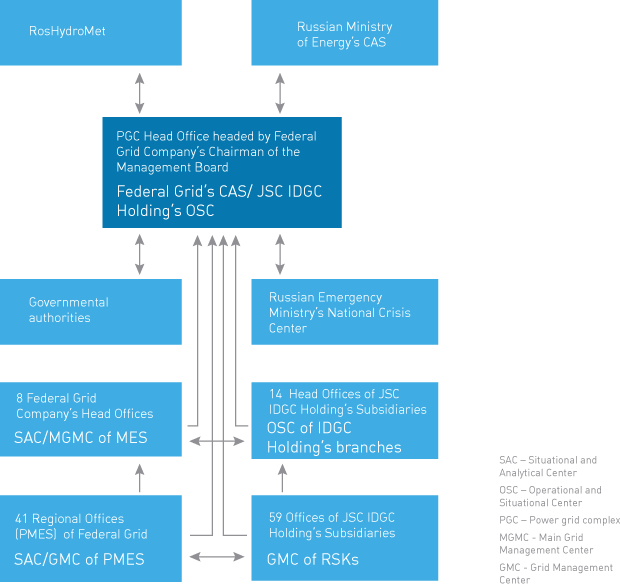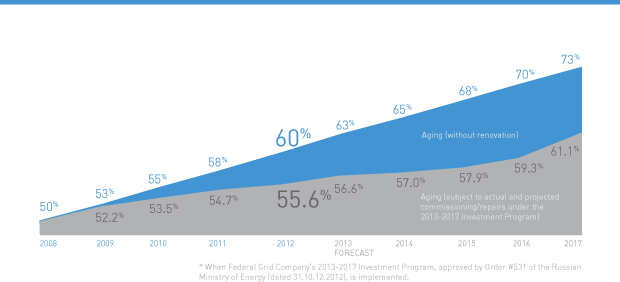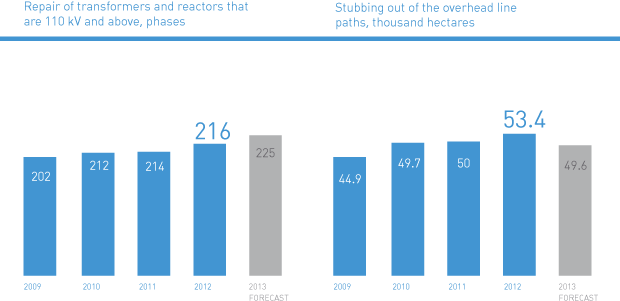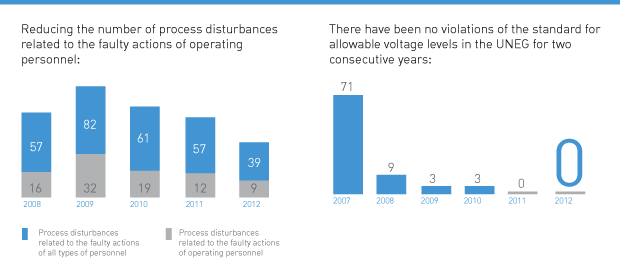- Federal Grid Company – Ten-year results
- Operations overview
- Social responsibility and sustainable development
- Financial performance overview
- Corporate governance report
- Share capital
-
APPENDICES
- Information on compliance with the FCSM corporate code of conduct
- Implementation of the assignments of the president and the government of the Russian Federation
- Information on transactions performed by JSC Federal Grid Company in 2012, recognized by russian federation laws as interested party transactions, and which are subject to the approval of the company’s authorized management body
- Audit Commission Conclusion on the Audit of Operational and Financial Activities of Federal Grid Company for 2012
- 2013 investor calendar
Upgrading reliability
Reliable and stable power supply guarantees the well-being and prosperity of any country, but in Russia, with its harsh northern climate, electricity supply reliability is strategically important. We understand the great responsibility that rests on us and we do our best to ensure that electricity reaches our consumers in a stable manner, without power setbacks and in compliance with all technical parameters.
In 2011-2012, thanks to planned work to maintain the normative condition of electric grid facilities, constructing new facilities and re-constructing existing ones and upgrading employee competence, the under-supply of electric energy to consumers has been reached at a stable low level. From 2009 to 2011, under abnormal environmental conditions, Federal Grid Company ensured the required reliability of electric grid facilities and stable UNEG operation, having fulfilled its obligations for reliable power supply to consumers, the following were prevented:
Measures adopted by our Company have reduced the specific (per 1,000 units) failure rate by 20%, compared with 2008:


Technical policy
The Company’s Regulations on Technical Policy were adopted in February 2011. The Policy is intended to determine the most advanced engineering requirements and solutions in the capital construction and operation of UNEG facilities, and to set basic priorities for the UNEG’s innovative and prospective development. Adhering to the Regulations on Technical Policy will enable the Company to optimize the use of the existing investment resources, to improve the efficiency of electric grid complex operation, to lower operating costs, to improve systemic reliability of the UNEG’s operation and to satisfy growing energy demand.
In November 2012, the Company’s Board of Directors approved the Regulations on the Unified Technical Policy in Russia’s electrical grid complex. These Regulations will be submitted to the Board of Directors of JSC IDGC Holding for approval.
The Unified Technical Policy in Russia’s electrical grid complex is aimed at determining the main technical areas that enhance the reliability and efficiency of Russia’s electrical grid complex in the short- and medium-term with appropriate industrial and environmental safety based on innovative development principles that provide non-discriminatory access to electric grids for all market participants.

We continue to cooperate with JSC IDGC Holding. Our mutual work during the year resulted in the adoption of rules of information exchange between branches of Federal Grid Company - MES and SDC JSC IDGC Holding. These rules allow us to obtain data on the time, place and circumstances of accidents in real time. In addition, we have developed a joint operation scheme for electrical grid facilities of Federal Grid Company and JSC IDGC Holding. We are also creating a unified database for emergency reserves and a joint main office for the electrical grid complex. In addition, together with JSC IDGC Holding, we have launched "hot lines" for round-the-clock operative response and information interactions with the public, electricity consumers and other electric power industry agents, as well as executive agencies on issues that concern reliable electric power supply.
Scheme of Federal Grid Company and JSC IDGC Holding’s joint efforts to ensure the reliable operation of the electric grid system in the event of an interruption of power supply to consumers and other contingency situations

Fixed Assets Renovation Program
On 31 October 2012, the Russian Ministry of Energy approved the Fixed Assets Renovation Program in the Company's 2013-2017 Investment Program. The Renovation Program, aimed at ensuring the reliable and efficient operation of the electric grid complex, provides for commissioning facilities with a total capacity of 31,357 MVA and reconstructing 1,231 km of electric energy transmission lines.
During the reporting year, as part of this program, we energized 23 key comprehensive facilities and 20 key facilities of non- comprehensive reconstruction. Among the most important renovation facilities are: the 220 kV Irtysh, the 220 kV Taksimo and the 500 kV Arzamasskaya substations. For the period from 2013 to 2017, total program financing amounted to RUR194,703 million. As part of complex reconstruction, 154 substations and 95 electric energy transmission lines are planned to be modernized. By increasing capital investment in new construction and renovation and implementing special programs to enhance safety, we managed to reverse the aging trend for both facilities and equipment.
Estimated and predicted aging of lines, taking into account changes in the steady operation of the power grid* (the expected renovation time for lines subject to new construction is 40 years, the length is more than 120,000 km)

Repair program
The annual repair program, as well as the timely and thorough preparation for special operation periods, allows the Company to maintain the normative state of equipment.The Company’s program is based on a year-by-year rolling plan for the five-year period.
Based on 2012 results, Federal Grid Company’s repair program was realized at 103% of the planned figure. The plan for stubbing out the overhead line paths was carried out at 101%.

Work during special periods
In 2008-2012, the Company achieved the target reliability level for the electric grid complex and ensured the stable operation of UES of Russia in conditions of abnormal natural phenomena (such as weather conditions). 2010 had a remarkably long hot spell, extensive forest fires and heavy icy rain in Moscow and the Moscow Region just before the New Year. During the summer of the reporting period, torrential rains resulted in a disaster in the Krasnodar Region, and December 2012 was the coldest one (December) in 70 years. Twenty-three temperature lows were set in that month. Beforehand, we prepared for peak loads in the electrical network during the autumn-winter period, seasonal floods, fires, storms, and how to prevent emergency situations related to power outages in major cities and regions.
During the 2012-2013 autumn-winter peak load period, we reduced the specific accident rate in the UNEG by 11.9% compared with the 2011-2012 autumn-winter period. That was made possible due to special measures undertaken by the Company aimed at making more intensive preparations for the special periods in 2012, including: a two-stage preliminary check for the readiness of electric grid facilities to work during the high load period. The General Directors of the Company’s branches - MES and JSC IDGC Holding’s subsidiaries prepared and approved a joint operational scheme for electric grid facilities and optimized resource allocation. As a result of this successful work, on 9November, the Company received a certificate of readiness for operation during the 2012-2013 autumn-winter period. This certificate certifies the timely and proper execution of a range of measures aimed at upgrading the reliability of power supply to consumers.
 17.07.2012
17.07.2012We completed all major power supply restoration work in the Tuapse District of the Krasnodar Region, which was affected by the flooding. In the first place, 6-10 kV power facilities that provided electricity transmission to ultimate consumers were restored. Then, the 0.4 kV consumer network was repaired. The Company’s 220-500 kV power lines and substations were not affected by the disaster and were operating normally. However, to ensure the high reliability of power facilities during the restoration period, line team specialists held off-schedule inspections on a daily basis.
Operational and process management
Operational and process management of Federal Grid Company is intended to ensure the reliable operation of UNEG facilities and the fulfillment of technological modes set by the System Operator’s control centers. Our task is to comply with quality and safety requirements when we operate UNEG facilities. We are actively working to reduce the number of process disturbances due to operating personnel errors, and are developing and carrying out UNEG development programs in collaboration with the System Operator’s control centers.
Moreover, we are commissioning new generation substations with modern automated equipment control systems. This enables us not to have our operational staff on duty at substations and delegates their functions to specialists at the network control centers. These innovations reduced maintenance costs and led to shorter elimination times for process disturbances.
In 2012, we successfully resolved the problems of operational and process management, which has enabled us to achieve the following results:


 square km
square km